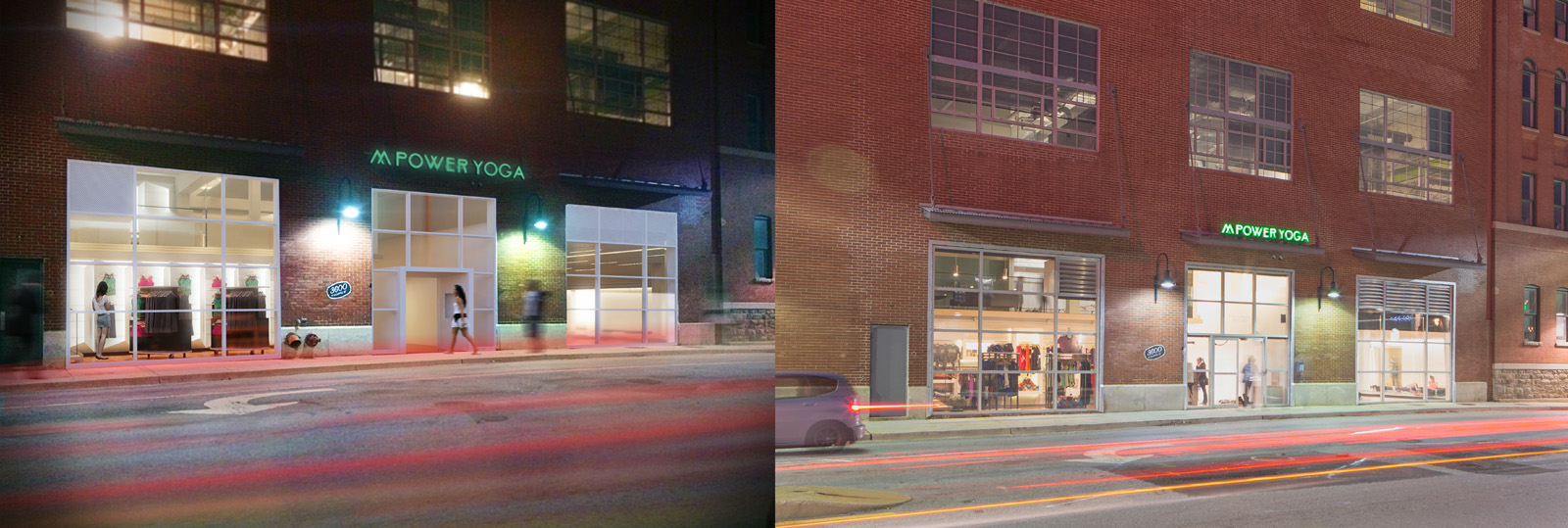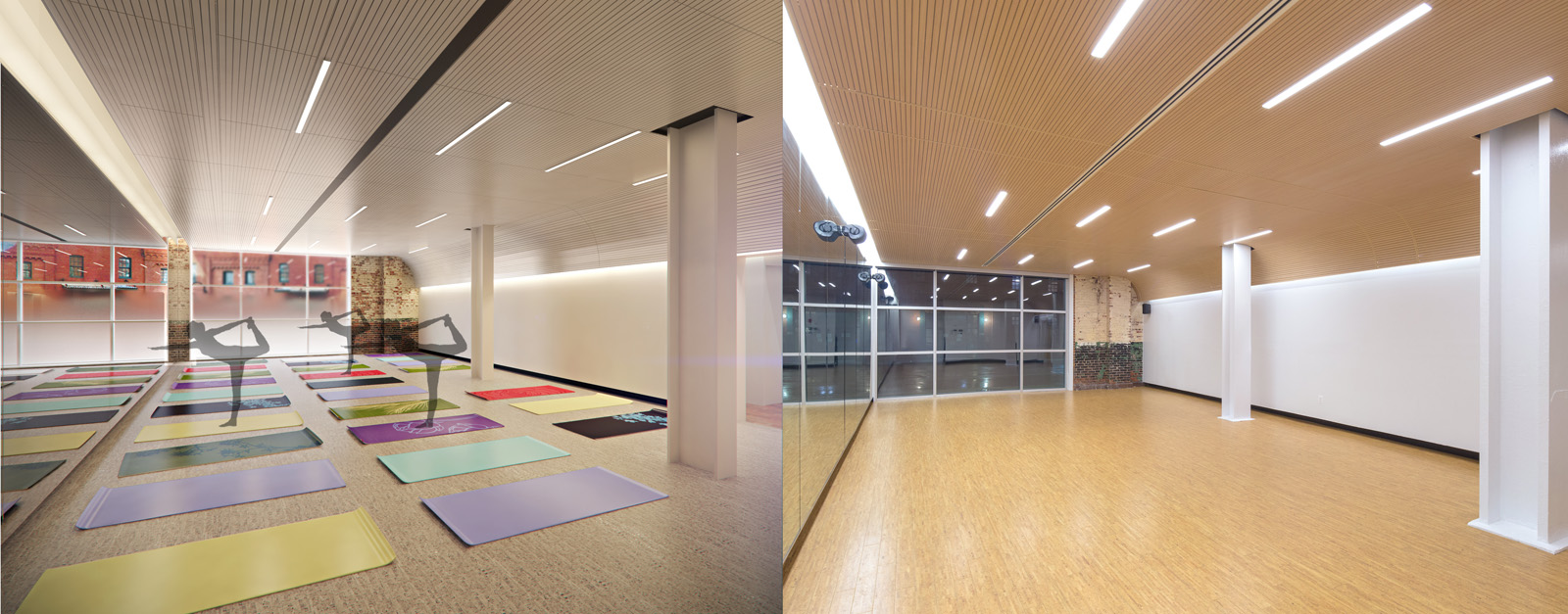Phone · 540-239-2336
J.Neal Architecture & Design
Email · Admin@JNeal
A Profile in Collaboration
 Left rendering of facade by Ben Althoff. Right photo of completed facade by Brett Gullborg
Left rendering of facade by Ben Althoff. Right photo of completed facade by Brett Gullborg
As a young start-up, in addition to our practice, we take time to ensure a focus on building relationships and collaborating with other creatives. We recently relocated our studio to share a space with Be The To Studios (and a local artist Shawn Gworek of City Lines Ink), an architectural visualization firm whom we have worked with on several projects in the past and hope to continue working with in the future. We have had great successes working in our own trades, and therefore came together to see what could happen when collaborating.
In light of this decision, and as a celebration to our joint successes, Jason Neal, our founder and namesake alongside Ben Althoff, Director of Visualization and founding partner of Be The To Studios talk a little about working with each other, and about M.Power Yoga, their most recent collaborative project, to profile the firm owners side by side:
Q: Can you expound upon your roles professionally?
Ben: I have multiple roles in order to run Be The To Studio (BTTS), but what we are is an architectural visualization firm. We essentially create the visual language to get the big architectural ideas across.
Jason: Well…I run a design daycare (chuckles)! So essentially, Jason Neal Design (JND) is a small firm executing large design outcomes. We’re creative, experimental, collaborative and open to a lot of new things that allow for interesting architecture and products, and I have the privilege of running it.
Q: When and how did you meet and what made you decide to first collaborate?
B: We were introduced by a mutual friend.
J: Yeah! This was back in January or February of 2014 when we first locked eyes. We were looking for a visualization artist for one of our first major commercial projects which needed some marketing material and lighting coordination and that was something we found out Ben knew how to do really well.
 Our photographer (Brett Gullborg) was able to capture two renderings in one panoramic photo of the locker room by making use of the vanity mirror.
Our photographer (Brett Gullborg) was able to capture two renderings in one panoramic photo of the locker room by making use of the vanity mirror.
Having graduated from Virgina Tech, Jason decided to move to Baltimore after receiving a job offer at an esteemed architecture firm, while Ben was a part time student at the Art Institute of San Diego (AISD) and currently works with the art department of Under Armour. Both in their early 30’s, raising families, each with young daughters of their own, Jason and Ben can commensurate in balancing the challenge of maintaining focus on both their family life and professional career.
Q: When did you decide you wanted to have your own company?
B: I knew I wanted to have my own company back in AISD in 2006. However, I knew I had to learn the business fast so I worked really hard and got a job within 7 months. And then October of 2014 is when we officially started Be The To Studio, but I have run my own freelance company since 2010.
J: Oh, I knew from the moment I made architecture my life’s work, which happened to be a Wednesday. The firm started in 2010, incorporated in 2011 and licensed and accredited in 2012.
Ben and Jason have a spent a lot of time inside and outside their workspace which has strengthened their connection. Their relationship has done a great deal for not just the M.Power project but other project opportunities to become the best it can be.
Q: At what point did you know you wanted your professional collaborations to extend into overlapping businesses?
B: I think that was pretty obvious to begin with. We both have our own skill-sets and understand the same field, so of course it would work.
J: And the M. Power Yoga project needed it. Just by distributing the work load to each of our expertise gave us an end result that was thorough even in quality.
Q: Can you tell me about the collaborative process specifically in regard to M. Power.
B: Jason and I are very particular about lighting…
J: Yup! Lighting can really make or break a space, it provides contrast and context. It’s how you really perceive a building. I mean, if you don’t have good lighting, then that changes the way someone would experience a space, and why lose a good design when all it takes is a little more thought to something as simple as lighting.
B: Knowing that, we used physically correct lighting models to achieve physically correct results. Obviously this shows in the M. Power renderings. This isn’t just for our own egos, but it allows the client to see their design realistically, before it is produced physically.
J: …and overall these renderings reassure that the end product will be closest to what we are imagining, what the clients expect, and it informs our own process
Working on M.Power was a strong project for both companies and the method of working has proven to be very effective for the project and us. This experience encourages and motivates us to continue with this frame of work and collaborate further on future projects, as there are many more to come! We look forward to continuing our work relationship and in the process allowing both our companies to achieve its full potential.
 The main studio fronting O’Donnell street rendering (left) against photo of completed space by Brett Gullborg (right).
The main studio fronting O’Donnell street rendering (left) against photo of completed space by Brett Gullborg (right).
 Mezzanine yoga/barre studio rendering by Ben Althoff (left) against photo of completed space by Brett Gullborg (right).
Mezzanine yoga/barre studio rendering by Ben Althoff (left) against photo of completed space by Brett Gullborg (right).
 Main entrance, reception and retail space. This was one of our first visions of the space, and it was incredibly rewarding to see that come to life. Rendering by Ben Althoff (left) against photo by Brett Gullborg (right).
Main entrance, reception and retail space. This was one of our first visions of the space, and it was incredibly rewarding to see that come to life. Rendering by Ben Althoff (left) against photo by Brett Gullborg (right).
 Lounge outside of mezzanine barre/yoga studio photo (left) by Brett Gullborg and rendering (right) by Ben Althoff.
Lounge outside of mezzanine barre/yoga studio photo (left) by Brett Gullborg and rendering (right) by Ben Althoff.